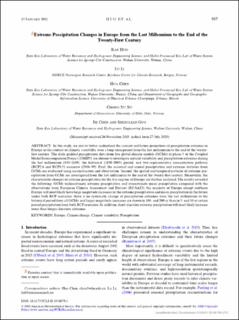| dc.contributor.author | Huo, Ran | |
| dc.contributor.author | Li, Lu | |
| dc.contributor.author | Chen, Hua | |
| dc.contributor.author | Xu, Chong-Yu | |
| dc.contributor.author | Chen, Jie | |
| dc.contributor.author | Guo, Shenglian | |
| dc.date.accessioned | 2021-02-15T12:39:39Z | |
| dc.date.available | 2021-02-15T12:39:39Z | |
| dc.date.created | 2020-12-27T15:14:28Z | |
| dc.date.issued | 2020 | |
| dc.identifier.citation | Journal of Climate. 2020, 34 567-588. | en_US |
| dc.identifier.issn | 0894-8755 | |
| dc.identifier.uri | https://hdl.handle.net/11250/2728100 | |
| dc.description.abstract | In this study, we aim to better understand the current and future projections of precipitation extremes in Europe in the context of climatic variability over a long-term period from the last millennium to the end of the twenty-first century. The daily gridded precipitation data from five global climate models (GCMs) of phase 5 of the Coupled Model Intercomparison Project (CMIP5) are chosen to investigate natural variability and precipitation extremes during the last millennium (850–1849), the historical (1850–2005) period, and two representative concentration pathway (RCP2.6 and RCP8.5) scenarios (2006–99). First, the seasonal and annual precipitation and extreme statistics from GCMs are evaluated using reconstruction and observation. Second, the spatial and temporal patterns of extreme precipitation from GCMs are investigated from the last millennium to the end of the twenty-first century. Meanwhile, the characteristic changes of extreme precipitation for the five regions of Europe are further analyzed. The results revealed the following: GCMs underestimate extreme precipitation and overestimate mean precipitation compared with the observations from European Climate Assessment and Dataset (ECA&D); the majority of Europe except southern Europe will most likely have large magnitude increases in the extreme precipitation and mean precipitation in the future under both RCP scenarios; there is no systematic change of precipitation extremes from the last millennium to the historical period from all GCMs; and larger magnitude increases are shown in 100- and 200-yr than in 5- and 10-yr return period precipitation from both RCP scenarios. In addition, short-duration extreme precipitation will most likely increase more than longer-duration extremes. | en_US |
| dc.language.iso | dan | en_US |
| dc.title | Extreme Precipitation Changes in Europe from the Last Millennium to the End of the Twenty-First Century | en_US |
| dc.type | Journal article | en_US |
| dc.type | Peer reviewed | en_US |
| dc.rights.holder | 2020 American Meteorological Society | |
| dc.description.version | publishedVersion | en_US |
| cristin.ispublished | true | |
| cristin.fulltext | original | |
| cristin.qualitycode | 2 | |
| dc.identifier.doi | 10.1175/JCLI-D-19-0879.1 | |
| dc.identifier.cristin | 1863384 | |
| dc.source.journal | Journal of Climate | en_US |
| dc.source.volume | 34 | en_US |
| dc.source.pagenumber | 567-588 | en_US |
| dc.relation.project | Norges forskningsråd: 274310 | en_US |
